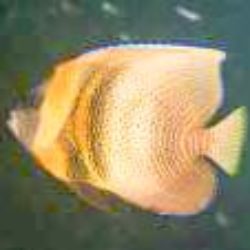Marine aquarium fish > Queen angelfish – Holacanthus ciliaris > Blue ring angelfish – Pomacanthus annularis
The Blue ring angelfish (Pomacanthus annularis) belongs to the Family Pomacanthidae (Angelfishes) in the order Perciformes (Perch-like) and in class Actinopterygii (ray-finned fishes).
The blue ring angelfish is a marine, reef-associated, tropical or subtropical, non-migratory fish, commonly found near the coral reefs in the warmer waters of the Indo-pacific region, spread over East coast of Africa, Madagascar, Sri Lanka, India, Indonesia, New Guinea, New Caledonia and south Japan.
Their preferred depth range is 1 – 60 meters. These angelfish are commercially collected for aquarium trade without any restrictions. These fish are also known as blue-ringed angelfish, annularis angelfish, blue king angelfish and ringed angelfish.
Appearance, physical description and identification
The body of blue ring angelfish is laterally compressed and has a oval profile and thin disc-shape. The single dorsal and anal fins are prolonged, the dorsal fin tip reaching nearly up to the caudal fin margin.
The caudal fins are squarish. The scales are overlapping, ctenoid (with comb-like posterior margin) and have yellow-orange rims. Scales in a longitudinal series above the lateral line are about 70. The preopercular region has spines. The dorsal head profile is clearly concave.
The small mouth is located on the anterior region of the head and its position is superior. The common size (TL) of the fish is 30 cm (12 inches) and maximum recorded length (TL) is 45 cm. These angelfish may live up to 20 years in wild conditions.
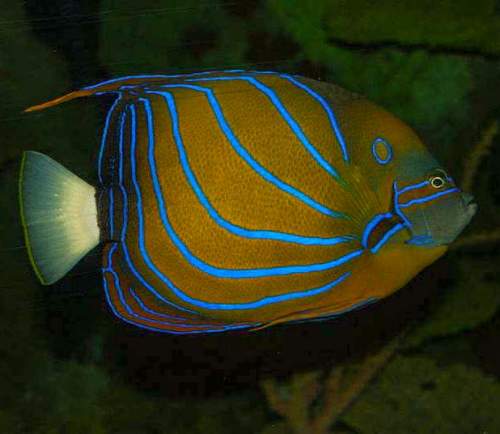
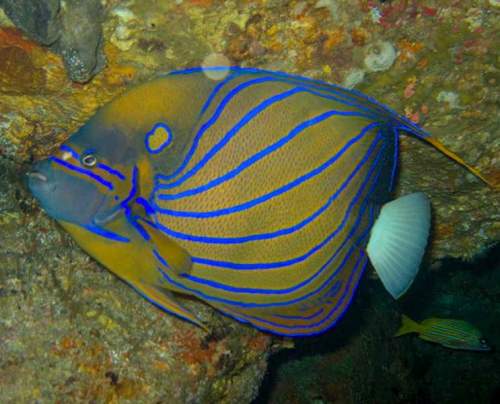
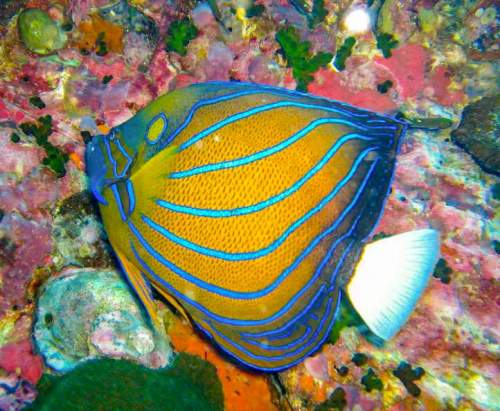
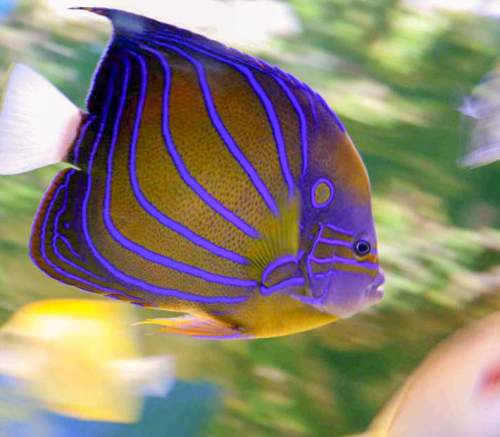
Coloration
The adult blue ring angelfish is golden brown or orange. The snout, part of the head and the base of dorsal and anal fins is diffusely colored bluish-violet. Curved, obliquely horizontal turquoise stripes (7 or 8) radiate from the pectoral-fin base area and run along the sides towards the posterior portion of the dorsal fin.
The stripes are well spaced and the upper stripe runs close to the base of the dorsal fin and the lower stripe runs close to the base of anal fin. Two horizontal turquoise stripes connect the opercular edges on either side, running along the face. One of them runs through the eye.
Two turquoise stripes are seen across the base of pectoral fin. There is a turquoise ring slightly behind and above the edge of operculum. The caudal fin is white with pale yellow margin. The juvenile blue ring angelfish have near black body with white and turquoise vertical stripes on the sides.
Meristics and morphometrics of blue ring angelfish
Lateral line: uninterrupted;
Total gill rakers: NA;
Dorsal fin: 1; extends over most of the dorsal length; total dorsal spines: 13; total dorsal soft rays: 20-21;
Adipose fin: absent;
Caudal fin: truncate;
Anal fin: 1; anal spines: 3; anal soft rays: 20 – 20;
Pectoral fin: soft rays: 18 – 20;
Blue ring angelfish habitat and ecosystem
These fish are found solitarily or in pairs near coral reefs, moving between corals, sponges and other sessile, macro reef fauna.
The blue ring angelfish occurs in ecosystems like Agulhas Current, Indian Ocean, Indonesian Sea, Milne Bay (south-eastern Papua New Guinea), Pacific Ocean, South China Sea, Southern Palawan Islands (Philippines), Sulu Sea (Philippines), Celebes Sea and Yellow Sea.
Origin, geographical range and distribution
The blue ring angelfish is native to 16 countries in the Indo-pacific region, occurring in extensive coral reef systems present there. These fish species are non-migratory and are resident to coral reef ecosystems.
They are native to Mozambique (Africa), India, Sri Lanka, Andaman Islands (India), Malaysia, Indonesia, Thailand, Cambodia, Vietnam, China, Hong Kong, Taiwan, Japan, Ogasawara Islands (Japan), Ryukyu Islands (Japan), Philippines, New Caledonia (French territory), Papua New Guinea and Solomon Islands. A single Pomacanthus annularis was collected in the Pompano Beach area of Florida in 1999, probably an aquarium release.
Blue ring angelfish behavior and adaptations
These fish species are well adapted for their life among corals. They are flattened laterally so that their movement between the corals and other reef macrofauna becomes easy. These angelfish are aggressive and highly territorial. Adult blue ring angelfish are found in pairs inside caves.
In a community aquarium, they must be the last specimen to be added. They have the habit of nibbling the substrate and hence they are not a candidate for reef aquarium. Now and then, they retreat to hiding places and caves in the aquarium.
Diet and feeding habits
The blue ring angelfish are foragers, feeding on a variety of sessile invertebrates and plants. Stomach contents of these fish reveal that their diet mostly consists of sponges, benthic algae, benthic weeds, tunicates, ascidians, and zoobenthos.
The juvenile fish are found to feed on sponges and tunicates. In aquarium environment, the young angelfish can be trained to feed on spirulina, brine shrimp, frozen worms, frozen fish, squid, scallops meat and formulated feeds. They must be fed three to four times in a day.
Blue ring angelfish reproduction and development
The male fish is slightly larger than the female and it is difficult to differentiate the sexes. They are egg-scatterers and usually breed soon after sunset. The eggs and sperms are released simultaneously into open sea and the fertilization takes place externally.
The eggs and the fry are not guarded and parental care is absent in these angelfish species. Spawning may occur more than once in a year. The eggs are pelagic and floating in open waters, hatch after 15 hours. The fry carries yolk sac, which will sustain it for 2 days.
By 48 hours the fry starts feeding on plankton and rapidly develops into a free swimming baby angelfish. After a month of growth, the juvenile fish, now about 2 to 3 cm in length settles to the bottom on the coral reefs.
Breeding blue ring angelfish in captivity
So far the blue ring angelfish has not bred successfully in captivity. In nature, breeding and spawning takes place in pelagic (open sea) conditions.
Blue ring angelfish aquarium care
Juvenile and adult fish are available online for aquarium keeping. However, they are highly priced. They are sold anywhere from $50 to several hundreds of dollars depending on their size and coloration. It is considered moderately hard to maintain these angelfish in captivity.
They require a large tank of 250 gallons or more. The quality of sea water is very important and near natural parameters must be maintained. For detailed information visit the pages on blue ring angelfish aquarium and quick facts.
Conservation status and concerns
IUCN Red List status has evaluated and listed these blue ring angelfish as of ‘Least Concern’ (LC). These fish are not considered endangered and there is no restriction on catching and collecting them for human use including aquarium trade.
CITES status is ‘Not Evaluated’. No threat to humans is perceived and the blue ring angelfish are considered “Harmless” to humans.
Reference: http://www.fishbase.org/summary/Pomacanthus-annularis.html
1.Image source: https://commons.wikimedia.org/wiki/File:EM_DSC_2212_(2877792781).jpg
Image author: Eddie Maloney | License: CC BY-SA 2.0
2.Image source: https://commons.wikimedia.org/wiki/File:Pomacanthus_annularis_2.jpg
Image author: jon hanson | License: https://creativecommons.org/licenses/by-sa/2.0/ CC BY-SA 2.0
3.Image source: https://www.flickr.com/photos/74904085@N03/8993196968/
Image author: Adam | License: https://creativecommons.org/licenses/by-nc/2.0/ CC BY-NC 2.0
4.Image source: https://www.flickr.com/photos/dennysytangco/186071145/
Image author: Denny Sytangco Photography | License: https://creativecommons.org/licenses/by-nc/2.0/ CC BY-NC 2.0
Current topic in Aquarium fish pictures: Blue ring angelfish – Pomacanthus annularis.

